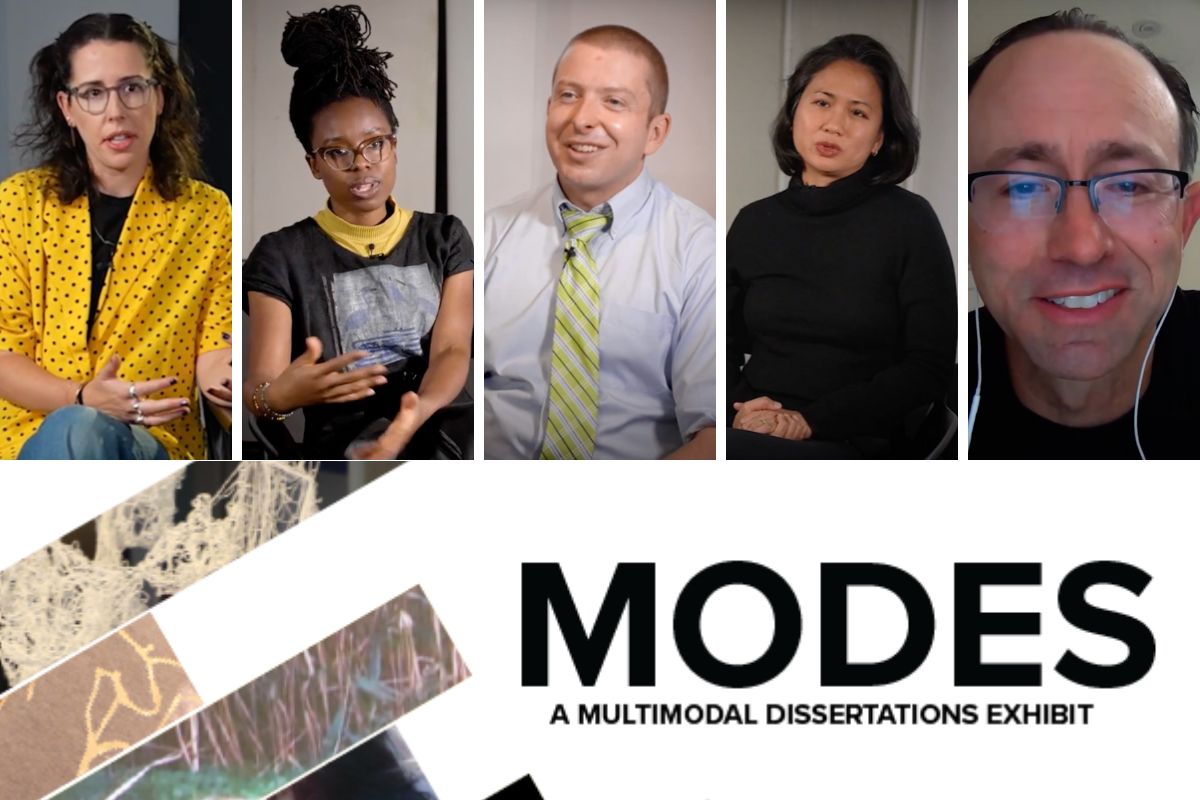A new video series from the Digital Futures Institute spotlights the breadth of multimodal, boundary-pushing scholarship happening at TC. MODES is based on the exhibit of the same name that launched last year and emerged from a conversation between DFI research scholars Chris Moffett and Lucius Von Joo. As a part of DFI’s Multimodal Scholarship Initiative, MODES furthers the goal of promoting and supporting innovation and creativity in research.
“Your dissertation is an opportunity to explore,” explains Moffett, who with Von Joo sees multimodal scholarship as uniquely suited to interactive presentations. These kinds of projects “bring people together to think about what these methods are, and create a dialogue and a sense of community.” For Von Joo, due to its “diverse methods for engagement among participants, researchers and spectators,” multimodal research brings complex issues into the “sphere of public scholarship,” he says.
Showcasing the dissertations of TC alum, faculty and post-docs, the MODES exhibit explored the creative potential and power of multimodal scholarship. Projects were hand selected by the curators who then worked with the researchers on the best way to highlight each project’s unique aspects. Moffett and Von Joo want people to “think [deeply] about what scholarship at TC looks like.”
Explore the world of multimodal dissertations in our conversation with Moffett and Von Joo below.
Abby Emerson
Abby Emerson’s (Ed.D. ’23) dissertation “Entanglements: An abolitionist and arts-informed curricular analysis of school-based antiracist professional development” was presented in two parts: a written manuscript that was “academy facing” and a series of 18 art pieces that were “practitioner facing” according to Emerson.
When presented at MODES, the curatorial team paid special attention to which of the pieces would work best in the space and modes of interaction. “That work was the one that was most visceral,” says Von Joo.
OreOluwa Badaki
Minority Postdoctoral Fellow OreOluwa Badaki presented her scholarship on food literacy through embodied storytelling, a methodology that uses the body to tell a story. The dissertation “Food Literacy Beyond the Plate: Exploring Creativity, Criticality, and Citizenship with Youth of Color Working in Urban Agriculture” was the culmination of a three-year ethnographic study and consisted of a written manuscript, a dance film based on a chapter about seed keeping and a screenplay written collaboratively with young people Badaki worked with.
The MODES exhibition presented Badaki’s dance film on a projection screen accompanied by a large canvas covered in paint and footprints, inviting viewers to quite literally follow her steps. “We thought about different ways … to leave that [physical record],” says Von Joo. “Because Ore works with public gardens, [we were thinking about] what it means to work with the land. We were thinking, what inks are produced from natural elements in that area? What are the canvases we happen to have? ...We were testing what it means for other people to interact with it smoothly as well.”
Kyle Oliver
Rev. Kyle Oliver’s (Ed.D. ’22) dissertation “Becoming Tapestry” presented ethnographic interviews with members of Tapestry, a foster youth mentoring organization. The podcast format was ideal for Oliver’s participatory research because of how it positioned participants as active contributors to the work, and gave them space to share their stories in their own words.
Curators of MODES had the challenge of designing a piece that showcased Oliver's intention of “protecting and carrying his participants' voices to the end,” says Von Joo. The end result put visitors in the role of interviewee in conversation with Oliver, complete with a mic and headphones.
Nick Sousanis
Nick Sousanis’s (Ed.D. ’14) award-winning comic book dissertation “Unflattening” was the first of its kind at TC and Columbia University. The dissertation explored the importance of visual modes in teaching and learning, and since it was entirely in comic-form, “Unflattening'' pushed readers to read and think about the content in new ways.
To present Sousanis’s work, the MODES curators decided to showcase the entire drafting process, from sketch to finished drawing, contextualizing the amount of work that went into each page of “Unflattening.” “When you foreground the multimodal nature of it,... it becomes evident that multimodality asks for more multimodality,” says Moffett. “The mode itself generates new innovations and questions around other methods of looking at those modes."
Tran Templeton
Assistant Professor of Early Childhood Education and TC alum Tran Templeton’s (Ed.D. ’18) dissertation examined how young children represent themselves through photography and what adults can learn about children from those images. Much of the dissertation, titled “‘I know how to take a picture’: Young children's photographs and the construction of identity” is a traditional manuscript, but it also includes a plethora of images taken by children.
For MODES, curators wanted to find a way of translating the metaphor of looking at the world from a child’s perspective into reality. “We're trying to allow somebody to see how it feels to look from both perspectives and what that means,” says Von Joo.
The result was a dual-sided display, showcasing images from the dissertation. One side put viewers into the position of a child photographer with an etching of a child’s hands holding a camera while the other side emulates a viewfinder, like you’d see on a boardwalk.
Watch this panel, moderated by Vice Dean for Digital Innovation and DFI Managing Director Lalitha Vasudevan, to hear more from the scholars featured in the 2023 exhibition of MODES.
